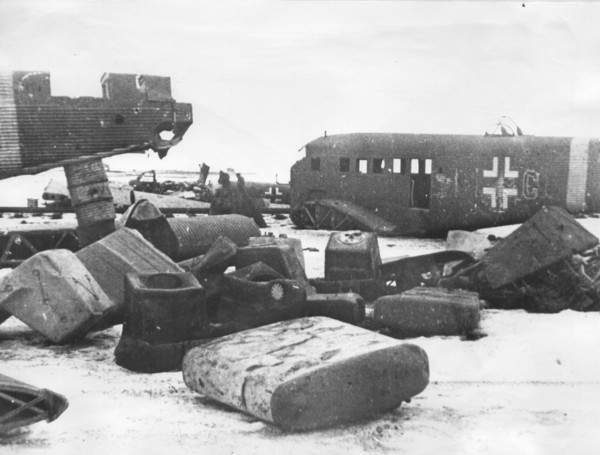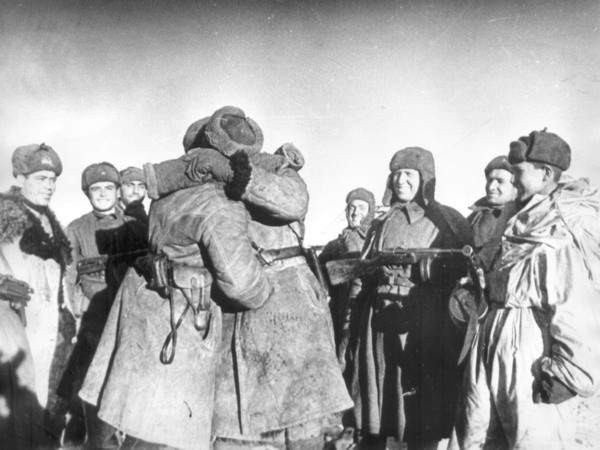 The front line units of the South-Western front met the divisions of the Stalingrad front in the area of the settlement Sovetskii to the east of Kalatch. Encircling of the enemy’s groups was over. The circle turned up to have 22 divisions and 160 separate units. The Head Commander of the Verrmaht, A. Hitler gave the uncompromising order to the commander of the 6th field army, general-colonel F. Paulus to remain on the occupied positions and to organize a round defense.
The front line units of the South-Western front met the divisions of the Stalingrad front in the area of the settlement Sovetskii to the east of Kalatch. Encircling of the enemy’s groups was over. The circle turned up to have 22 divisions and 160 separate units. The Head Commander of the Verrmaht, A. Hitler gave the uncompromising order to the commander of the 6th field army, general-colonel F. Paulus to remain on the occupied positions and to organize a round defense.
In the end of November the German command formed a new group of armies called “Don” (commander – General-Field Marshall A. Manstein). Part of this group advanced from the area of the city Kotelnikovo on the 12th of December targeting at freeing the encircled. But the tank divisions of the army group “Got” were stopped during the brutal battles with the soviet forces and then destroyed at the river Myshkova. Right at the same time with this operation, the soviet forces began the expansion in the north of Don. This advancement operation forced the German command to decline the thought of unblocking the encircled group. The forces of the left wing of the Voronezh, the Southwestern and the Stalingrad fronts had wiped out the enemy in front of the outside front of encirclement and had thrown the leftovers of its units back at the distance of 150-200 km. This way the suitable conditions for the liquidation of the encircled Verrmaht forces at the Stalingrad.
 In December an attempt to organize the supplying of the encircled group with the help of aviation in the area of Stalingrad was prevented, the German air forces lost more than 700 air planes. By the beginning of January, 1943 the number of the German fascists forces had been cut down to 250 thousand people, it contained 300 tanks, 4130 armaments and mortars and 100 military planes. The responsibility for carrying out the destruction of this group was entrusted to the enforced by the additional units 7 armies of the Don front, the armies of which were overpowering the enemy in artillery in 1,7 times, in planes – in 3 times, but losing to the numbers of men and tanks in 1,2 times. The representative of the Soviet Headquarters was the general-colonel of the artillery N. Voronov. After the enemy had rejected the proposal of capitulation, on the 10th of January the forces of the Don front advanced again, which had been preceded by the powerful artillery and air force preparation. In accordance with the idea of the operation, which got the code name “The Ring”, the 65th army was to produce the major strike in the direction of Stalingrad from the west. By the end of January the soviet forces emerged at the banks of the river Rossoshka, the second defense line on the enemy. In order to break it the major efforts were sent to the line of the 21st army, the forces of which had torn down the enforcements of Verrmaht. In the evening of the 26th of January at the north-western side of the Mamaev Hill the forces of the army joined the 62nd army approaching them from Stalingrad. The group of the German fascist forces was separated into two parts. On the 31st of December the southern group of forces of the 6th army headed by the general-field marshal F. Paulus gave in, and the northern group capitulated on the 2nd of February. From the 10th of January to the 2nd of February, the forces of the Don front imprisoned 91thousand of soldiers and officers of the enemy, about 140 thousand men had been killed during the advancement operation.
In December an attempt to organize the supplying of the encircled group with the help of aviation in the area of Stalingrad was prevented, the German air forces lost more than 700 air planes. By the beginning of January, 1943 the number of the German fascists forces had been cut down to 250 thousand people, it contained 300 tanks, 4130 armaments and mortars and 100 military planes. The responsibility for carrying out the destruction of this group was entrusted to the enforced by the additional units 7 armies of the Don front, the armies of which were overpowering the enemy in artillery in 1,7 times, in planes – in 3 times, but losing to the numbers of men and tanks in 1,2 times. The representative of the Soviet Headquarters was the general-colonel of the artillery N. Voronov. After the enemy had rejected the proposal of capitulation, on the 10th of January the forces of the Don front advanced again, which had been preceded by the powerful artillery and air force preparation. In accordance with the idea of the operation, which got the code name “The Ring”, the 65th army was to produce the major strike in the direction of Stalingrad from the west. By the end of January the soviet forces emerged at the banks of the river Rossoshka, the second defense line on the enemy. In order to break it the major efforts were sent to the line of the 21st army, the forces of which had torn down the enforcements of Verrmaht. In the evening of the 26th of January at the north-western side of the Mamaev Hill the forces of the army joined the 62nd army approaching them from Stalingrad. The group of the German fascist forces was separated into two parts. On the 31st of December the southern group of forces of the 6th army headed by the general-field marshal F. Paulus gave in, and the northern group capitulated on the 2nd of February. From the 10th of January to the 2nd of February, the forces of the Don front imprisoned 91thousand of soldiers and officers of the enemy, about 140 thousand men had been killed during the advancement operation.
The victory of the Red Army in the Stalingrad Battle had a great world-wide political and military importance. It has formed the beginning for the core change in the stream of the Great Patriotic War and the World War II. Soviet forces deprived the enemy of the strategic initiative and kept holding it till the end of the war.
 Since July of 1942 up to February of 1943 the German fascist forces lost more than 800 thousand soldiers and officers between the rivers Don and Volga. R armies of the enemy underwent complete destruction (2 German armies, 2 Romanian armies and 1 Italian army).
Since July of 1942 up to February of 1943 the German fascist forces lost more than 800 thousand soldiers and officers between the rivers Don and Volga. R armies of the enemy underwent complete destruction (2 German armies, 2 Romanian armies and 1 Italian army).
The defeat in the Stalingrad battle came to be a serious moral and political distress for the nazi Germany and it has weakened its political position in the world. Japan was forced to refuse its plan of taking the active actions against the USSR. The powerful circles of Turkey strengthened in their wish to keep neutral in this conflict. The victory at Stalingrad rose the world wide authority of the Soviet Union, it happened to be an important component for the following enforcement of the anti-Hitler coalition. It also demonstrated the growing power of the Red Army and the military skills of its commanders. During the Stalingrad Battle for the first time the Red Army carried out the advancing group operation of encircling and destroying a large enemy group. But the victory has been acquired for a very expensive price. Soviet forces lost more than 1,1 million people.
[1]
[2]
[3]
[4]
[5]